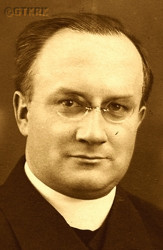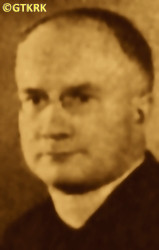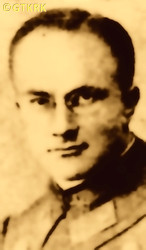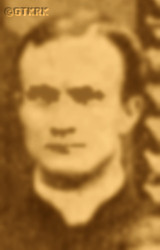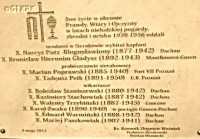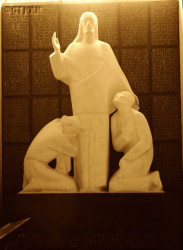Roman Catholic
St Sigismund parish
05-507 Słomczyn
85 Wiślana Str.
Konstancin deanery
Warsaw archdiocese, Poland
full list:
displayClick to display full list

searchClick to search full list by categories
wyświetlKliknij by wyświetlić pełną listę po polsku

szukajKliknij by przeszukać listę wg kategorii po polsku

Martyrology of the clergy — Poland
XX century (1914 – 1989)
personal data
surname
GŁADYSZ
forename(s)
Bronislav (pl. Bronisław)
forename(s)
versions/aliases
Bronislav Jerome (pl. Bronisław Hieronim)
function
diocesan priest
creed
Latin (Roman Catholic) Church RCmore on
en.wikipedia.org
[access: 2014.09.21]
diocese / province
Gniezno and Poznań archdiocese (aeque principaliter)more on
www.archpoznan.pl
[access: 2012.11.23]
RC Military Ordinariate of Polandmore on
en.wikipedia.org
[access: 2014.12.20]
academic distinctions
Habilitation Doctor of Literature
honorary titles
„Medal of Independence”more on
en.wikipedia.org
[access: 2019.02.02]
(08.11.1937)
Commemorative Medal for War of 1918–21more on
pl.wikipedia.org
[access: 2019.10.13]
date and place
of death
19.06.1943

KL Gusen Iconcentration camp
today: n. St. Georgen an der Gusen, Sankt Georgen an der Gusen, Perg dist., Salzburg state, Austria
more on
en.wikipedia.org
[access: 2022.01.09]
details of death
During the Prussian rule in part of partitioned Poland, while studying at the Germ. Königliches Gymnasium (Eng. Royal Gymnasium) in Gniezno (until 1911), a member of the clandestine Polish self–educational Thomas Zan Society student organization. In 1907, temporarily expelled from school by the German authorities for participating in a school strike — school strikes, in opposition to the Prussian order to use the German language in prayers and religious education — covered almost the entire Greater Poland.
In 1916‐1918, during World War I, drafted into German army as the chaplain of 7th Reserve Infantry Regiment (serving in Poznań hospitals).
After the abdication of the German Emperor William II Hohenzollern on 09.11.1918, after the armistice between the Allies and Germany signed on 11.11.1918 in the HQ wagon in Compiègne, the HQ of French Marshal Ferdinand Foch — which de facto meant the end of World War I; after on 11.11.1918 the Regency Council established by the Germans, operating in the territory of the so‐called Germ. Königreich Polen (Eng. Polish Kingdom) occupied by Germany and Austria–Hungary, handed over supreme authority over the army to Brigadier Joseph Piłsudski and appointed him Commander‐in‐Chief of the Polish Army — which de facto meant the rebirth of the Polish state, covering however only the area of the Germ. Königreich Polen, i.e. the Polish territory under Russian rule until 1915, and excluding the lands of the Prussian partition, which were still under German control; chairman of the Polish Peasant and Soldier Council in Szkaradowo (Rawicz district) — a town in the south of the Germ. Provinz Posen (Eng. Poznań Province) within the Germ. Königreich Preußen (Eng. Kingdom of Prussia), which was part of the German Empire, right on the border with the Germ. Provinz Schlesien (Eng. Silesia Province) — where was a vicar. Formally, however, the Council was still a unit of local government within the German state.
After the outbreak on 27.12.1918 of the Greater Poland Uprising of 1918‐1919, Szkaradowo came under the control of the insurgents, while the capital of the district, Rawicz, was under the German control. Co‐organizer of a Polish volunteer unit that joined the insurgent forces. There are indications that was targeted by agents of the Germ. Grenzschutz Ost (Eng. Eastern Border Guard), a paramilitary volunteer formation that militarily opposed the separation of the eastern territories from Germany, perhaps from the unit in Rawicz. „He miraculously escaped with his life”. At the beginning of 02.1919, called up as a chaplain to the 1st Reserve Regiment of Greater Poland Riflemen, formed, among others, from soldiers of the Dąbrowski's 2nd Poznań Regiment, famous for the capture of Ławica near Poznań on 06.01.1919 and the military airport located there — and the largest war booty in the history of Polish arms (including over 300 aircraft). The Regiment was sworn in on 04.02.1919 in Poznań, and already on 07.02.1919 its 2nd Battalion was transferred to the northern front of the Uprising, and took part in the attack from Kcynia towards Nakło on Noteć, capturing Paterek. The next day the Battalion entered Nakło and then successfully defended this town and the Kcynia–Szubin line in bloody clashes, after which on 11.04.1919 was recalled to Poznań. Meanwhile the 1st Battalion fought near Zbąszyń. The clashes along the Noteć river continued, despite the fact that on 16.02.1919 an armistice ending the Uprising was signed in Trier, forced by the victorious Entente countries. The Polish insurgent Greater Poland Army was then recognized as an allied army and a border was set, which „German troops were forbidden to cross”, leaving Greater Poland outside their influence. However, it was not until the Treaty of Versailles, concluded on 28.06.1919 (after ratifications came into force on 10.01.1920), that Greater Poland was formally awarded to Poland. Already on 05.05.1919, the Regiment — on 15.03.1919 renamed the 10th Greater Poland Rifle Regiment — set off back to the northern front, to the line Gołańcz – Budzyń – Kruszewo. There, despite the armistice, fought several battles with the Germans, including during reconnaissance towards Bydgoszcz, attacking the bridge on the Noteć Canal near Rynarzewo, after which it retreated to Szubin.
On 22.06.1919 the Regiment leaves for Eastern Lesser Poland, to the front of the Polish–Ukrainian War of 1918‐1919. On the night of 27‐28.06.1919 attacked Berezhany, and it took on 29.06.1919, breaking through the front. Began pursuing the demoralized enemy and on 17.07.1919 took Husyatyn and the bridgehead on the eastern bank of the Zbruch. 08.08.1919 the Regiment was sent to Volyn, where Bolshevik troops were rampant. Reached Teofipol without encountering resistance, halfway between Kremenets and Proskuriv, disarming the Bolshevised population along the way (among other things, about 3,000 light rifles were confiscated).
19.09.1919, via Ternopil, the Regiment returns to Krotoszyn in Greater Poland, becoming part of the 3rd Greater Poland Rifle Division (soon renamed the 17th Infantry Division).
On 01.02.1920 it is renamed the 68th Greater Poland Infantry Regiment.
In 02.1920 transported to the Lithuanian–Belarusian Front, stationed near Maladzyechna, in reserve of the 1st Army. The Polish–Russian War of 1919‐1921 is already underway. On c. 14.05.1920 the first Russian offensive begins. On 14‐18.05.1920 The Regiment defends its position around the village of Krulevshchina, at the sources of the Berezina River. The offensive was stopped and on 04.06.1920 the front line restored to its previous line. On 04.07.1920 the great Russian offensive began. The Polish troops started to retreat. The Regiment retreated in continuous clashes and skirmishes with the attacking Russians, along the line of Kovali, Puzyri, Smarhon, Geraneny, Lunno on Neman, Sadykierz near Pułtusk (names of the villages where these clashes took place) down to Modlin north of Warsaw. There, on 15‐16.08.1920 the counterattack begins — as part of the great Battle of Warsaw (known as the „Miracle on the Vistula”) — the Regiment attacked north, through the village of Toruń Dworski towards Nasielsk, cutting the main northern line of the Russian attack. On 16.08.1920 it captures Nasielsk and began chasing the fleeing Russians towards Pułtusk. On 18.08.1920 captured this town and crossed the Narew River. However, it immediately returned to the western bank of the river and set off in pursuit of the Russians towards Różan. On 20.08.1920, it fought its last battle of the campaign near the village of Szelków. The Russians were defeated. The Regiment moved through, among others, Przasnysz to Suwałki, arriving there on 18.09.1920 and was stationed there until 01.12.1920, securing, among other things, the demarcation line with Lithuania.
Released from the army already in 10.1920, returning to his ministry in his diocese.
In 1927 and 1929 appointed reserve chaplain of the Polish Army (each time for a statutory period of 2 years).
After German and Russian invasion of Poland in 09.1939 and start of the World War II, after start of German occupation, member of clandestine resistance Polish National Party (1939‐1941) and chaplain and advisor of its National Combat Organization NOB arm, established on 16.11.1939 Poznań.
Arrested by the Germans on 18.07.1941.
Held in UH Posen jail at Młyńska Str. in Poznań.
From there moved to KL Posen concentration camp.
Next held in Wronki and Zwickau prisons.
Accused of membership of „illegal” Polish National Party and of reading and distribution of illegal clandestine leaflets sentenced on 14.05.1942 in Zwickau, by German Germ. Oberlandsgericht (Eng. Higher Provincial Court) of Poznań — at an away session in Zwickau — to 5 years in penal camps.
On 03.07.1942 transferred to Rawicz prison.
Finally on 11.12.1942 transported to KL Gusen I concentration camp — part of KL Mauthausen‐Gusen concentration camps' complex — where slaved in quarries and where perished.
cause of death
murder
perpetrators
Germans
sites and events
KL Gusen IClick to display the description, KL Mauthausen‐GusenClick to display the description, RawiczClick to display the description, KL Zwickau / Schloß OstersteinClick to display the description, WronkiClick to display the description, KL PosenClick to display the description, UH PosenClick to display the description, Reichsgau WarthelandClick to display the description, Ribbentrop‐MolotovClick to display the description, Pius XI's encyclicalsClick to display the description, Polish‐Russian war of 1919‐1921Click to display the description, Greater Poland UprisingClick to display the description
date and place
of birth
03.09.1892Birth certification on:
photos.szukajwarchiwach.gov.pl
[access: 2025.08.19]

Sierakówtoday: Sieraków gm., Międzychód pov., Greater Poland voiv., Poland
more on
en.wikipedia.org
[access: 2021.12.18]
parents
GŁADYSZ Anthony
🞲 ?, ? — 🕆 ?, ?

SOKOŁOWSKA Theodosia
🞲 ?, ? — 🕆 ?, ?
presbyter (holy orders)
ordination
13.02.1916

Gnieznotoday: Gniezno urban gm., Gniezno pov., Greater Poland voiv., Poland
more on
en.wikipedia.org
[access: 2021.12.18]
Assumption of the Blessed Virgin Mary RC archcathedral churchmore on
en.wikipedia.org
[access: 2025.03.14]
positions held
1933 – 1941
parish priest — PoznańStarołęka district
form.: till 1924 independent Starołęka Mała village
today: Poznań city pov., Greater Poland voiv., Poland
more on
en.wikipedia.org
[access: 2022.08.05] ⋄ St Anthony of Padua RC parish ⋄ Poznańtoday: Poznań city pov., Greater Poland voiv., Poland
more on
en.wikipedia.org
[access: 2021.07.18] RC deanery
1924 – 1933
administrator — PoznańStarołęka district
form.: till 1924 independent Starołęka Mała village
today: Poznań city pov., Greater Poland voiv., Poland
more on
en.wikipedia.org
[access: 2022.08.05] ⋄ St Anthony of Padua RC parish ⋄ Poznańtoday: Poznań city pov., Greater Poland voiv., Poland
more on
en.wikipedia.org
[access: 2021.07.18] RC deanery
1932
postdoctoral degree (habilitation) — Poznańtoday: Poznań city pov., Greater Poland voiv., Poland
more on
en.wikipedia.org
[access: 2021.07.18] ⋄ Department of Humanities, Poznań University [i.e. Adam Mickiewicz University (from 1955) / Poznań University (1945‐1955, 1920‐1939) / Piast University (1919‐1920) / Polish University (1918‐1919) / Royal Academy (1903‐1918)] — specialization: medieval Latin literature
from 1928
secretary — Poznańtoday: Poznań city pov., Greater Poland voiv., Poland
more on
en.wikipedia.org
[access: 2021.07.18] ⋄ Theological Committee, Friends of Sciences Society
till 1926
PhD student — Poznańtoday: Poznań city pov., Greater Poland voiv., Poland
more on
en.wikipedia.org
[access: 2021.07.18] ⋄ Department of Humanities, Poznań University [i.e. Adam Mickiewicz University (from 1955) / Poznań University (1945‐1955, 1920‐1939) / Piast University (1919‐1920) / Polish University (1918‐1919) / Royal Academy (1903‐1918)] — PhD thesis „Fr Matthew Sarbiewski and the reform of breviary hymns in the times of Pope Urban VIII”), public defense on 08.02.1926, ed. Poznań 1927
1922 – 1924
curatus/rector/expositus — Starołęka Małatoday: district in Poznań, Poznań city pov., Greater Poland voiv., Poland
more on
en.wikipedia.org
[access: 2021.07.18] ⋄ St Anthony of Padua RC church ⋄ Głuszynatoday: neighborhood in Poznań, Poznań pov., Greater Poland voiv., Poland
more on
en.wikipedia.org
[access: 2021.07.18], St James the Great the Apostle RC parish ⋄ Poznańtoday: Poznań city pov., Greater Poland voiv., Poland
more on
en.wikipedia.org
[access: 2021.07.18] RC deanery
1922
vicar — Chojnicavillage
today: non‐existent, Suchy Las gm., Poznań pov., Greater Poland voiv., Poland
more on
en.wikipedia.org
[access: 2022.07.21] ⋄ Beheading of St John the Baptist RC parish ⋄ Szamotułytoday: Szamotuły gm., Szamotuły pov., Greater Poland voiv., Poland
more on
en.wikipedia.org
[access: 2021.06.20] RC deanery — acting („ad interim”)
1921 – 1922
vicar — Kopanicatoday: Siedlec gm., Wolsztyn pov., Greater Poland voiv., Poland
more on
en.wikipedia.org
[access: 2022.02.03] ⋄ Blessed Virgin Mary of the Assumption RC parish ⋄ Zbąszyńtoday: Zbąszyń gm., Nowy Tomyśl pov., Greater Poland voiv., Poland
more on
en.wikipedia.org
[access: 2021.06.20] RC deanery — acting („ad interim”)
1921
vicar — Świerczynatoday: Osieczna gm., Leszno pov., Greater Poland voiv., Poland
more on
en.wikipedia.org
[access: 2020.11.27] ⋄ St Luke the Evangelist RC parish ⋄ Gostyńtoday: Gostyń gm., Gostyń pov., Greater Poland voiv., Poland
more on
en.wikipedia.org
[access: 2021.07.18] RC deanery
10.1920 – 1921
vicar — Ostrów Wielkopolskitoday: Ostrów Wielkopolski urban gm., Ostrów Wielkopolski pov., Greater Poland voiv., Poland
more on
en.wikipedia.org
[access: 2021.06.07] ⋄ St Stanislav the Bishop and Martyr RC parish ⋄ Ostrów Wielkopolskitoday: Ostrów Wielkopolski urban gm., Ostrów Wielkopolski pov., Greater Poland voiv., Poland
more on
en.wikipedia.org
[access: 2021.06.07] RC deanery — also: prefect at gymnasium for girls
1919 – 1921
RC military chaplain — Polish Armed Forces — from 02.1919 service in the 1st Reserve Regiment of Greater Poland Riflemen, on 15.03.1919 renamed the 10th Greater Poland Riflemen Regiment (as part of the 3rd Greater Poland Riflemen Division), and on 01.02.1920 renamed the 68th Greater Poland Infantry Regiment (as part of the 17th Infantry Division); formally accepted into the Polish Army as a chaplain by L. 2238 decree of the Commander‐in‐Chief of 30.07.1920; discharged on 10.1920; on 27.02.1921 by decree L. 1395 of the Commander‐in‐Chief released from active service; verified with seniority from 01.06.1919, in the rank of captain
1918 – 1919
vicar — Szkaradowotoday: Jutrosin gm., Rawicz pov., Greater Poland voiv., Poland
more on
en.wikipedia.org
[access: 2021.07.18] ⋄ St Martin the Bishop and Confessor RC parish ⋄ Jutrosintoday: Jutrosin gm., Rawicz pov., Greater Poland voiv., Poland
more on
en.wikipedia.org
[access: 2021.12.19] RC deanery
1918
vicar — Komandoriatoday: neighborhood in Poznań, Poznań city pov., Greater Poland voiv., Poland
more on
en.wikipedia.org
[access: 2021.07.18] ⋄ St John of Jerusalem Outside the Walls RC parish ⋄ Poznańtoday: Poznań city pov., Greater Poland voiv., Poland
more on
en.wikipedia.org
[access: 2021.07.18] RC deanery
1916 – 1918
RC military chaplain — Poznańtoday: Poznań city pov., Greater Poland voiv., Poland
more on
en.wikipedia.org
[access: 2021.07.18] ⋄ German Imperial Army — formally chaplain of the 7th Reserve Infantry Regiment, stationed prob. in Nowa Sól and practicing on Biedrusko training ground c. 15 km north of Poznań; in practice ministered in Poznań hospitals
1916 – 1918
vicar — Poznańtoday: Poznań city pov., Greater Poland voiv., Poland
more on
en.wikipedia.org
[access: 2021.07.18] ⋄ St Martin the Bishop and Confessor RC parish ⋄ Poznańtoday: Poznań city pov., Greater Poland voiv., Poland
more on
en.wikipedia.org
[access: 2021.07.18] RC deanery
till 1916
student — Gnieznotoday: Gniezno urban gm., Gniezno pov., Greater Poland voiv., Poland
more on
en.wikipedia.org
[access: 2021.12.18] ⋄ philosophy and theology, Archbishop's Practical Theological Seminary (Lat. Seminarium Clericorum Practicum)
from 1911
student — Poznańtoday: Poznań city pov., Greater Poland voiv., Poland
more on
en.wikipedia.org
[access: 2021.07.18] ⋄ philosophy and theology, Archbishop's Theological Seminary (Collegium Leoninum)
author of c. 50 articles and publications, in Polish, Latin, French and German, e.g. „Biographies of eminent saints, including their symbolism”, Poznań 1921; Lat. „Officum in Gratiaum Actione pro Victoria Chocimensi” (Eng. „Officium on Thanksgiving for the Victory at Khotim”), 1928; „Dogmatic Texts in the Poetic Works of Sedulius. A Study in the History of Dogmas of the V Century”, 1930; „On Latin Church Hymns from Polish Medieval Sources”, 1930; Lat. „De extremis quibus Seduliana carmina ornantur verborum syllabis inter se consonantibus” (Eng. „The Ends of the Verses of Coelius Sedulius Are Adorned with Syllables of Words That Concord with Each Other”), 1931; „Hymns of the Roman Breviary and the Prayers to the Saints. Translation and Explanations”, 1933; „On Latin Rhymed Offices from Polish Medieval Sources”, 1933; „Statute of the Łęczyca Synod of 1285 on 'B. Adalberts' History' In New Illumination”, 1934; Germ. „Nachklänge der Wiener Jubiläumsfeier (1683‐1933) in der neuesten Geschithtsforschung” (Eng. „Echoes of the Anniversary Celebrations of Vienna (1683‐1933) in the Latest Historical Research”), 1934; „On the Study of Latin Medieval Philology in Poland”, 1936; „Latin Mass Sequences from Polish Medieval Sources”, 1937; in the periodicals such as „Classical Quarterly”, „Theological Review”, „Priestly Athenaeum”, „Eos”, „Literary diary”, „Theologische praktische Quartalschrift”, „City of Poznań Chronicle”, „Collectanea Theologica”, „Mysterium Christi”
from 1934
secretary — Poznańtoday: Poznań city pov., Greater Poland voiv., Poland
more on
en.wikipedia.org
[access: 2021.07.18] ⋄ Theological Committee, Friends of Sciences Society — from 1928 member
comments
Perhaps during the Polish–Russian War of 1919‐1921 ministered in the 61st Greater Poland Infantry Regiment (such information can be found in the entry about his release from active service in the „Personnel Journal” of the Ministry of Military Affairs.
others related
in death
PAUSEClick to display biography Casimir Henry
sites and events
descriptions
KL Gusen I: German Germ. Konzentrationslager (Eng. concentration camp) KL „Grade III” (Germ. „Stufe III”), part of KL Mauthausen‐Gusen complex, intended for the „Incorrigible political enemies of the Reich”. The prisoners slaved at a nearby granite quarry, but also in local private companies: at SS guards houses' construction at a nearby Sankt Georgen for instance. Initially opened in 05.1940 as the „camp for Poles”, captured during the program of extermination of Polish intelligentsia («Intelligenzaktion»). Till the end most of the prisoners were Poles. Many Polish priests from the Polish regions incorporated in the Germany were brought there in 1940, after start of German occupation of Poland, from KL Sachsenhausen and KL Dachau concentration camps. (more on: en.wikipedia.orgClick to attempt to display webpage
[access: 2014.03.10])
KL Mauthausen‐Gusen: A large group of German Germ. Konzentrationslager (Eng. concentration camp) KL camps set up around the villages of Mauthausen and Gusen in Upper Austria, c. 30 km east of Linz, operational from 1938 till 05.1945. Over time it became of the largest labour camp complexes in the German‐controlled part of Europe encompassing four major camps concentration camps (KL Mauthausen, KL Gusen I, KL Gusen II and KL Gusen III) and more than 50 sub‐camps where inmates slaved in quarries — the granite extracted, previously used to pave the streets of Vienna, was intended for a complete reconstruction of major German towns according to the plans of the chief architect of National Socialist Germany, the Germ. Generalbauinspektor für die Reichshauptstadt (Eng. General Building Inspector for the Reich Capital) and from 1942 also, i.a. the Germ. Reichsminister für Bewaffnung und Munition (Eng. Reich Minister for Armaments and Ammunition), Albert Speer — munitions factories, mines, arms factories and Me 262 fighter‐plane assembly plants. The complex served the needs of the German war machine and also carried out extermination through labour. Initially did not have a its own gas chamber and the intended victims were mostly moved to the infamous euthanasia center in the Schloss Hartheim castle w Alkoven, 40.7 km east, or killed by lethal injection and cremated in the local crematorium. Later a van with the exhaust pipe connected to the inside shuttled between KL Mauthausen and KL Gusen. In 12.1941 a permanent gas chamber was built. C. 122,000‐360,000 of prisoners perished. Many Polish priests were held, including those captured during the program of extermination of Polish intelligentsia («Intelligenzaktion»). The camp complex was founded and run as a source for cheap labour for private enterprise. (more on: en.wikipedia.orgClick to attempt to display webpage
[access: 2014.03.10])
Rawicz: Prison, founded in 1819‐1821, in place of the Franciscan Friars Minor's monastery, which was liquidated by the Prussian occupation authorities. During the World War II, during the German occupation of 1939‐1945, the German Germ. Zuchthaus (Eng. heavy prison), intended for men sentenced to long‐term imprisonment and penal camp sentences, levied mainly by the Germ. Warthegau (Eng. Wartha region) occupation courts. A large part of the prisoners were next transported from there to German concentration camps. After the end of the military operations of World War II, the prison was managed by the Commie‐Nazi authorities of the Russian prl republic. Many activists of the Polish clandestine independence underground were detained there, including soldiers of the Home Army AK. Political prisoners were finally released in 1956. (more on: pl.wikipedia.orgClick to attempt to display webpage
[access: 2013.08.17])
KL Zwickau / Schloß Osterstein: A heavy German prison in Zwickau in Saxony, founded in 1770‐1775 at the Schloß Osterstein castle. In the XIX c., among its detainees were Karl May, August Bebel, Rosa Luxemburg. During World War II, prob. had the status of Germ. Konzentrationslager (Eng. concentration camp) KL Zwickau / Schloß Osterstein and political prisoners were held there under an extralegal system, euphemistically known as the German Schutzhaft (Eng. protective custody). Prisoners, living in overcrowded cells, slave laboured in the city receiving starvation rations. (more on: en.wikipedia.orgClick to attempt to display webpage
[access: 2010.08.11])
Wronki: Penal prison in 1939‐1945 managed by the Germans — called Strafgefüngnis Wronki — for the prisoners sentenced to 6 months to 2 years incarceration, mainly Poles. Altogether up to 28,000 inmates were held there. After 1945 it was a jail for political prisoners, „enemies” of Russian‐Polish Commie‐Nazis. (more on: www.sw.gov.plClick to attempt to display webpage
[access: 2013.08.17], pl.wikipedia.orgClick to attempt to display webpage
[access: 2013.08.17])
KL Posen: German Posen — Fort VII — camp founded in c. 10.10.1939 in Poznań till mid of 11.1939 operated formally as Germ. Konzentrationslager (Eng. concentration camp) KL Posen, and this term is used throughout the White Book, also later periods. It was first such a concentration camp set up by the Germans on Polish territory — in case of Greater Poland (Wielkopolska) directly incorporated into German Reich. In 10.1939 in KL Posen for the first time Germans used gas to murder civilian population, in particular patients of local psychiatric hospitals. From 11.1939 the camp operated as German political police Gestapo prison and transit camp (Germ. Übergangslager), prior to sending off to concentration camps, such as KL Dachau or KL Auschwitz. In 28.05.1941 the camp was rebranded as police jail and slave labour corrective camp (Germ. Arbeitserziehungslager). At its peak up to 7‐9 executions were carried in the camp per day, there were mass hangings of the prisoners and some of them were led out to be murdered elsewhere, outside of the camp. Altogether in KL Posen Germans exterminated approx. 20,000 inhabitants of Greater Poland (Wielkopolska) region, including many representatives of Polish intelligentsia, patients and staff of psychiatric hospitals and dozen or so Polish priests. Hundreds of priests were held there temporarily prior to transport to other concentration camps, mainly KL Dachau. From 03.1943 the camp had been transformed into an industrial complex (from 25.04.1944 — Telefunken factory manufacturing radios for submarines and aircrafts). (more on: www.wmn.poznan.plClick to attempt to display webpage
[access: 2019.02.02], en.wikipedia.orgClick to attempt to display webpage
[access: 2013.12.27])
UH Posen: Germ. Untersuchungshaftanstalt Posen (Eng. Poznań Detention Centre), run by the Germ. Geheime Staatspolizei (Eng. Secret State Police), i.e. Gestapo, at 1 Młyńska Str. in Poznań. Death sentences by guillotine and hanging were also carried out there — in total, during World War II, the Germans are said to have murdered at least 1,639 people there (1,532 men, 93 women and 14 children — people under the age of 18), including c. 1,400 people who were probably killed by guillotine. Convicts in custody were greeted: Germ. „Wir werden auch mit dir fertig sein — Kopf herunter” (Eng. „We will finish you too — keep your head down”). Sentences were usually carried out on Tuesdays and Fridays, around on 06:00. According to the testimony of one of the German executioners: „Two assistants took the condemned by the arms and led him to a bench, where they laid him face down. The head stuck out above the bathtub. A special board pressed the condemned man's neck. At the prosecutor's call, the executioner dropped a knife weighing 2–3 hundredweight. The severed head fell into the bathtub”. (more on: pl.wikipedia.orgClick to attempt to display webpage
[access: 2013.10.05])
Reichsgau Wartheland: After the Polish defeat in the 09.1939 campaign, which was the result of the Ribbentrop‐Molotov Pact and constituted the first stage of World War II, and the beginning of German occupation in part of Poland (in the other, eastern part of Poland, the Russian occupation began), the Germans divided the occupied Polish territory into five main regions (and a few smaller). The largest one was transformed into Germ. Generalgouvernement (Eng. General Governorate), intended exclusively for Poles and Jews and constituting part of the so‐called Germ. Großdeutschland (Eng. Greater Germany). Two were added to existing German provinces. From two other separate new provinces were created. Greater Poland region was one of them, incorporated into Germany on 08.10.1939, by decree of the German leader Adolf Hitler (formally came into force on 26.10.1939), and on 24.01.1940 transformed into the Germ. Reichsgau Wartheland (Eng. Wartheland Reich Province), in which the law of the German state was to apply. The main axis of the policy of the new province, the territory of which the Germans recognized as the Germ. „Ursprünglich Deutsche” (Eng. „natively German”), despite the fact that 90% of its inhabitants were Poles, was Germ. „Entpolonisierung” (Eng. „Depolonisation”), i.e. forced Germanization. C. 100,000 Poles were murdered as part of the Germ. „Intelligenzaktion”, i.e. extermination of Polish intelligentsia and ruling classes. C. 630,000 were forcibly resettled to the Germ. Generalgouvernement, and their place taken by the Germans brought from other areas occupied by Germany (e.g. the Baltic countries, Bessarabia, Bukovina, etc.). Poles were forced to sign the German nationality list, the Germ. Deutsche Volksliste DVL. As part of the policy of „Ohne Gott, ohne Religion, ohne Priesters und Sakramenten” (Eng. „No God, no religion, no priest or sacrament”) most Catholic priests were arrested and sent to concentration camps. All schools teaching in Polish, Polish libraries, theaters and museums were closed. Polish landed estates confiscated. To further reduce the number of the Polish population, Poles were sent to forced labor deep inside Germany, and the legal age of marriage for Poles was increased (25 for women, 28 for men). The German state office, Germ. Rasse‐ und Siedlungshauptamt (Eng. Main Office of Race and Settlement) RuSHA, under the majesty of German law, abducted several thousand children who met specific racial criteria from Polish families and subjected them to forced Germanization, handing them over to German families. After the end of hostilities of World War II, the overseer of this province, the Germ. Reichsstatthalter (Eng. Reich Governor) and the Germ. Gauleiter (Eng. district head) of the German National Socialist Party, Arthur Karl Greiser, was executed. (more on: en.wikipedia.orgClick to attempt to display webpage
[access: 2024.06.21])
Ribbentrop‐Molotov: Genocidal Russian‐German alliance pact between Russian leader Joseph Stalin and German leader Adolf Hitler signed on 23.08.1939 in Moscow by respective foreign ministers, Mr. Vyacheslav Molotov for Russia and Joachim von Ribbentrop for Germany. The pact sanctioned and was the direct cause of joint Russian and German invasion of Poland and the outbreak of the World War II in 09.1939. In a political sense, the pact was an attempt to restore the status quo ante before 1914, with one exception, namely the „commercial” exchange of the so‐called „Kingdom of Poland”, which in 1914 was part of the Russian Empire, fore Eastern Galicia (today's western Ukraine), in 1914 belonging to the Austro‐Hungarian Empire. Galicia, including Lviv, was to be taken over by the Russians, the „Kingdom of Poland” — under the name of the General Governorate — Germany. The resultant „war was one of the greatest calamities and dramas of humanity in history, for two atheistic and anti‐Christian ideologies — national and international socialism — rejected God and His fifth Decalogue commandment: Thou shall not kill!” (Abp Stanislav Gądecki, 01.09.2019). The decisions taken — backed up by the betrayal of the formal allies of Poland, France and Germany, which on 12.09.1939, at a joint conference in Abbeville, decided not to provide aid to attacked Poland and not to take military action against Germany (a clear breach of treaty obligations with Poland) — were on 28.09.1939 slightly altered and made more precise when a treaty on „German‐Russian boundaries and friendship” was agreed by the same murderous signatories. One of its findings was establishment of spheres of influence in Central and Eastern Europe and in consequence IV partition of Poland. In one of its secret annexes agreed, that: „the Signatories will not tolerate on its respective territories any Polish propaganda that affects the territory of the other Side. On their respective territories they will suppress all such propaganda and inform each other of the measures taken to accomplish it”. The agreements resulted in a series of meeting between two genocidal organization representing both sides — German Gestapo and Russian NKVD when coordination of efforts to exterminate Polish intelligentsia and Polish leading classes (in Germany called «Intelligenzaktion», in Russia took the form of Katyń massacres) where discussed. Resulted in deaths of hundreds of thousands of Polish intelligentsia, including thousands of priests presented here, and tens of millions of ordinary people,. The results of this Russian‐German pact lasted till 1989 and are still in evidence even today. (more on: en.wikipedia.orgClick to attempt to display webpage
[access: 2015.09.30])
Pius XI's encyclicals: Facing the creation of two totalitarian systems in Europe, which seemed to compete with each other, though there were more similarities than contradictions between them, Pope Pius XI issued in 03.1937 (within 5 days) two encyclicals. In the „Mit brennender Sorge” (Eng. „With Burning Concern”) published on 14.03.1938, condemned the national socialism prevailing in Germany. The Pope wrote: „Whoever, following the old Germanic‐pre‐Christian beliefs, puts various impersonal fate in the place of a personal God, denies the wisdom of God and Providence […], whoever exalts earthly values: race or nation, or state, or state system, representatives of state power or other fundamental values of human society, […] and makes them the highest standard of all values, including religious ones, and idolizes them, this one […] is far from true faith in God and from a worldview corresponding to such faith”. On 19.03.1937, published „Divini Redemptoris” (Eng. „Divine Redeemer”), in which criticized Russian communism, dialectical materialism and the class struggle theory. The Pope wrote: „Communism deprives man of freedom, and therefore the spiritual basis of all life norms. It deprives the human person of all his dignity and any moral support with which he could resist the onslaught of blind passions […] This is the new gospel that Bolshevik and godless communism preaches as a message of salvation and redemption of humanity”… Pius XI demanded that the established human law be subjected to the natural law of God , recommended the implementation of the ideal of a Christian state and society, and called on Catholics to resist. Two years later, National Socialist Germany and Communist Russia came together and started World War II. (more on: www.vatican.vaClick to attempt to display webpage
[access: 2023.05.28], www.vatican.vaClick to attempt to display webpage
[access: 2023.05.28])
Polish‐Russian war of 1919‐1921: War for independence of Poland and its borders. Poland regained independence in 1918 but had to fight for its borders with former imperial powers, in particular Russia. Russia planned to incite Bolshevik‐like revolutions in the Western Europe and thus invaded Poland. Russian invaders were defeated in 08.1920 in a battle called Warsaw battle („Vistula river miracle”, one of the 10 most important battles in history, according to some historians). Thanks to this victory Poland recaptured part of the lands lost during partitions of Poland in XVIII century, and Europe was saved from the genocidal Communism. (more on: en.wikipedia.orgClick to attempt to display webpage
[access: 2014.12.20])
Greater Poland Uprising: Military insurrection of Poles of former German Germ. Posen Provinz (Eng. Poznań province) launched against German Reich in 1918‐1919 — after the abdication on 09.11.1918 of the German Emperor William II Hohenzollern; after the armistice between the Allies and Germany signed on 11.1.1918 in the HQ wagon in Compiègne, the headquarters of Marshal of France Ferdinand Foch — which de facto meant the end of World War I — against the German Weimar Republic, established on the ruins of the German Empire, aiming to incorporate lands captured by Prussia during partitions of Poland in XVIII century into Poland. The Republic of Poland, reborn on 11.11.1918, initially formally included only the so‐called Germ. Königreich Polen (Eng. Kingdom of Poland), i.e. the territory that had been under Russian rule until 1915 and then under the control of Central States (Germany and Austria–Hungary), but did not include the Prussian partition. Started on 27.12.1918 in Poznań and ended on 16.02.1919 with the armistice pact in Trier, forced by the victorious Entente states, which included provisions ordering Germany to cease operations against Poland and, importantly, recognizing the Polish insurgent Greater Poland Army as an allied armed force of the Entente. De facto it turned out to be a Polish victory, confirmed in the main peace treaty after World War I, the Treaty of Versailles of 28.06.1919, which came into force on 10.01.1920 and in which most of the lands of the Prussian partition were recognized as Polish. Many Polish priests took part in the Uprising, both as chaplains of the insurgents units and members and leaders of the Polish agencies and councils set up in the areas covered by the Uprising. In 1939 after German invasion of Poland and start of the World War II those priests were particularly persecuted by the Germans and majority of them were murdered. (more on: en.wikipedia.orgClick to attempt to display webpage
[access: 2016.08.14])
sources
personal:
www.wtg-gniazdo.orgClick to attempt to display webpage
[access: 2012.11.23], www.filipini.poznan.plClick to attempt to display webpage
[access: 2012.11.23], www.straty.plClick to attempt to display webpage
[access: 2016.03.14], photos.szukajwarchiwach.gov.plClick to attempt to display webpage
[access: 2025.08.19], pl.wikipedia.orgClick to attempt to display webpage
[access: 2014.03.21], pw.ipn.gov.plClick to attempt to display webpage
[access: 2019.04.16], www.filipini.poznan.plClick to attempt to display webpage
[access: 2012.11.23]
bibliographical:
„Social Activist Priests in Greater Poland”, collective work, Biographical Dictionary, vol. 4 Ś‐Ż, Gniezno 2009
original images:
ro.com.plClick to attempt to display webpage
[access: 2016.05.30], commons.wikimedia.orgClick to attempt to display webpage
[access: 2024.12.13], wielkopolskahistorycznie.plClick to attempt to display webpage
[access: 2024.12.13], www.wbc.poznan.plClick to attempt to display webpage
[access: 2016.08.14], www.parafia.sierakow.plClick to attempt to display webpage
[access: 2014.01.06]
LETTER to CUSTODIAN/ADMINISTRATOR
If you have an Email client on your communicator/computer — such as Mozilla Thunderbird, Windows Mail or Microsoft Outlook, described at WikipediaPatrz:
en.wikipedia.org, among others — try the link below, please:
LETTER to CUSTODIAN/ADMINISTRATORClick and try to call your own Email client
If however you do not run such a client or the above link is not active please send an email to the Custodian/Administrator using your account — in your customary email/correspondence engine — at the following address:

giving the following as the subject:
MARTYROLOGY: GŁADYSZ Bronislav
To return to the biography press below:
 Click to return to biography
Click to return to biography








